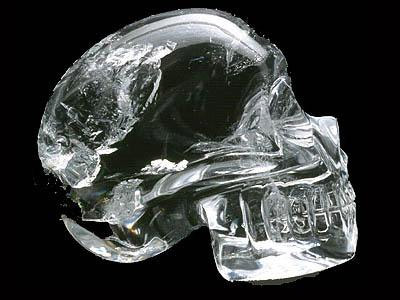 On 1 January, 1924, Britain’s Anna Mitchell Hedges discovered a crystal skull beneath an alter in a pyramid temple in the lost Mayan city of Lubaantun (meaning the city of the fallen stones in the Mayan language).
On 1 January, 1924, Britain’s Anna Mitchell Hedges discovered a crystal skull beneath an alter in a pyramid temple in the lost Mayan city of Lubaantun (meaning the city of the fallen stones in the Mayan language).
The skull was the same size as a genuine human skull and consists entirely of transparent quartz.
Since the crystal contained no carbon, the skull was subjected to a range of tests by scientists from the world-renowned company Hewlett-Packard. The resuts stunned the scientists. One of them described these unbelievable results in the words, “This skull should never have existed!”
The results that revealed that the crystal skull could only have been made using advanced technology are as follows:
1. A team of scientists revealed that the skull has been made out of a form of quartz known as piezoelectric silicon dioxide, used in the current telecommunications sector and with a higher memory capacity than other. Latest micro-processors are made from the same substance. Even more striking, however, is the fact that this form of crystal was only discovered in the 19th century.
2. This crystal, piezoelectric silicon dioxide, is both negative and positively polarized. This means that, as with batteries, it is able to produce its own electricity.
3. Scientists used a series of polarized test lights to establish that the cranium and the lower jaw of the skull, in the form of two separate components, were made from the same block of crystal rock. Considering that quartz crystal is softer and more brittle than diamond, the fact the skull was carved from a single piece of crystal, which is almost impossible, amazed scientists.
4. Under the microscope, scientists found no trace suggesting that modern automatic equipment or mechanical devices had been used on the skull. Scientists concluded that it was impossible to produce such a delicate and fine component as the lower jaw, from a single piece of crystal, even using modern diamond-tipped electrical equipment, without shattering it.
5. Scientists calculated that the crystal skull could have been made without any equipment, abrading it with a piece of diamond, but that this would have needed several generations over a period of some 300 years.
 6. Present-day crystals are carved around their axes. Because crystals have a molecular symmetry. In order not to break the crystal, it has to be cut in line with that natural structure, its molecular symmetry, in other words. Even if lasers of high-tech cutting techniques are used, crystals will still shatter if not cut along their natural axes. But even though this crystal skull was cut in a manner totally independent of its axis, no fracturing or cracking arose, in complete violation of the laws of physics.
6. Present-day crystals are carved around their axes. Because crystals have a molecular symmetry. In order not to break the crystal, it has to be cut in line with that natural structure, its molecular symmetry, in other words. Even if lasers of high-tech cutting techniques are used, crystals will still shatter if not cut along their natural axes. But even though this crystal skull was cut in a manner totally independent of its axis, no fracturing or cracking arose, in complete violation of the laws of physics.
7. Scientists were also astonished by the skull’s optical features. As a result of the Hewlett-Packard tests, scientists realized that the skull had interesting optical properties. Light applied from beneath the skull should normally be refracted in all directions, but in this skull it formed a channel focusing on the eye sockets and emerging from these.
8. Another startling optical feature is the prism lower to the lower rear section of the skull. All light rays striking the eye sockets are reflected from this prism. Therefore, when you look directly into the sockets you can see the whole room inside the eyes of the crystal skull.
Structures that present-day technology still struggles to account for, such as Stonehenge in England, constructed 8,000 years ago, the Egyptian pyramids, the T-shaped animal motifs carved 11,000 years ago on Gobekli Tepe in Urfa, Turkey and the 10-ton Sun gate carved from a single rock, prove that people in ancient times were not primitive and lacking any comprehension of art, science and technology, as is sometimes claimed. Evolutionists have attempted to apply the same perverse, evolutionary logic they sought to apply to such branches of science as biology, paleontology, and zoology to archeology, as well. But as with this crystal skull, artifacts left behind from people who lived in the past scientifically refute the evolutionist claim that ape-like beings gradually developed into today’s man


